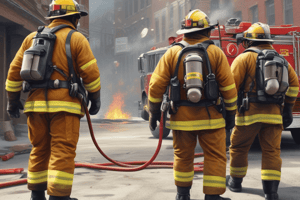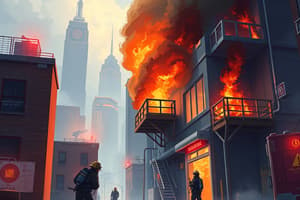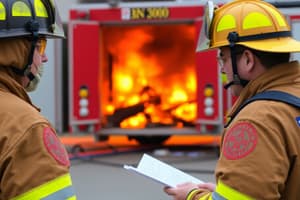Podcast
Questions and Answers
What is the top priority for fire departments during a fire incident?
What is the top priority for fire departments during a fire incident?
- Saving lives and property (correct)
- Ensuring firefighter safety
- Protecting property
- Containing the fire
What is the highest priority for firefighters at the incident scene?
What is the highest priority for firefighters at the incident scene?
- Saving lives
- Ensuring their own safety (correct)
- Containing the fire
- Protecting property
What is necessary to protect firefighters during a fire incident?
What is necessary to protect firefighters during a fire incident?
- Advanced technology
- A strong water supply
- A large number of firefighters
- Proper tactics and training (correct)
Who plays a critical role in ensuring firefighter safety at the incident scene?
Who plays a critical role in ensuring firefighter safety at the incident scene?
Why is analyzing firefighter injuries and fatalities important?
Why is analyzing firefighter injuries and fatalities important?
How does NFPA 1500 define occupational injury?
How does NFPA 1500 define occupational injury?
What trend do NFPA statistics show in on-duty firefighter deaths over 42 years?
What trend do NFPA statistics show in on-duty firefighter deaths over 42 years?
Why should fire departments examine injuries, fatalities, and near miss accidents?
Why should fire departments examine injuries, fatalities, and near miss accidents?
What do several organizations publish fire investigative reports on?
What do several organizations publish fire investigative reports on?
Why should large loss of life incidents, such as 9/11, be evaluated?
Why should large loss of life incidents, such as 9/11, be evaluated?
What should fire departments do to prevent on-duty deaths and injuries?
What should fire departments do to prevent on-duty deaths and injuries?
What does NFPA 1500 provide minimum safety requirements for?
What does NFPA 1500 provide minimum safety requirements for?
Flashcards are hidden until you start studying
Study Notes
- Fire departments prioritize saving lives and property from fire.
- Fire fighter safety is the highest priority at the incident scene.
- Proper tactics and training are necessary to protect fire fighters.
- The incident safety officer plays a critical role in ensuring fire fighter safety.
- Analyzing fire fighter injuries and fatalities is important to reducing future incidents.
- NFPA 1500 defines occupational injury as an injury sustained during fire department duties.
- NFPA statistics show a downward trend in on-duty fire fighter deaths over 42 years.
- Fire departments should examine injuries, fatalities, and near miss accidents to prevent future incidents.
- Several organizations publish fire investigative reports analyzing individual fires resulting in fatalities.
- Large loss of life incidents, such as 9/11, are not included in NFPA reports but should still be evaluated to reduce catastrophic incidents.
- Fire departments should appoint a safety officer to analyze and prevent on-duty deaths and injuries.
- NFPA 1500 provides minimum safety requirements for fire-ground operations.
- Personal protective equipment and breathing apparatus have improved since 1977.
- Firefighters are expected to perform additional emergency tasks, necessitating extra training.
- Lightweight construction and heavy fire loads increase the risk to firefighters.
- Most firefighter fatalities occur in home fires.
- Nonresidential occupancy types pose a greater risk to firefighters once a fire occurs.
- The chances of a firefighter fatality are 8.7 times greater when combating a manufacturing occupancy fire.
- The loss of air supply is more likely to be fatal in a larger, more complex building.
- The fire ground remains a hazardous environment for firefighters.
- Firefighting is a dangerous job.
- It is important to analyze the nature and cause of firefighter fatalities.
- Cardiac events and asphyxiation are the leading causes of on-duty firefighter fatalities at structure fires.
- Sudden cardiac deaths account for almost one-third of firefighter fatalities at structure fires.
- Many of these deaths are preventable through proper medical evaluation and wellness programs.
- Firefighters face a high risk of injury and death on the job.
- Analyzing firefighter fatalities can help identify areas for improvement in safety and prevention.
- Cardiac events are a significant risk for firefighters and can often be prevented with proper medical care.
- Asphyxiation is another leading cause of firefighter fatalities at structure fires.
- Wellness programs can help reduce the risk of on-duty firefighter fatalities.
Studying That Suits You
Use AI to generate personalized quizzes and flashcards to suit your learning preferences.




